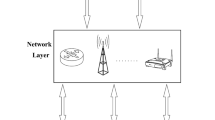Abstract
IEEE 802.11ah is proven to be a suitable communication standard for Internet of Things. It supports a wide range of modulation and coding schemes (MCSs) along with different data rates. The Restricted Access Windows (RAW)-based channel access mechanism facilitates scalable communication among a large number of devices. However, due to the absence of RAW size adjustment, it fails to optimally utilize the resources in a dynamic network environment. In this paper, we propose a method to estimate the RAW size based on traffic loads and provide relay node support for stations to use different MCSs. The relay nodes dynamically allocate bandwidth to stations belonging to different relay groups. The proposed scheme is seamlessly assimilated into 802.11ah which shows significant performance improvement in terms of throughput and delay.













Similar content being viewed by others
References
Ahmed N, Hussain MI (2016) A distributed channel access mechanism for IEEE 802.11 ah. In: IEEE world forum on Internet of Things (WF-IoT). IEEE, pp 1–6
Ahmed N, Hussain MI (2016) Relay-based IEEE 802.11ah network: a Smart City solution. In: Cloudification of the Internet of Things (CIoT). IEEE, pp 1–6
Ahmed N, Rahman H, Hussain MI (2016) A comparison of 802.11ah and 802.15.4 for IoT. ICT Express 2(3):100–102
Anouar H, Bonnet C (2007) Optimal constant-window backoff scheme for IEEE 802.11 DCF in single-hop wireless networks under finite load conditions. Wirel Pers Commun 43(4):1583–1602
Bianchi G (2000) IEEE 802.11 Distributed coordination function. IEEE J Sel Areas Commun 18(3):535–547
Chapman L, Muller CL, Young DT, Warren EL, Grimmond C, Cai XM, Ferranti EJ (2015) The Birmingham urban climate laboratory: an open meteorological test bed and challenges of the Smart City. Bull Am Meteorol Soc 96(9):1545–1560
Hazmi A, Rinne J, Valkama M (2012) Feasibility study of IEEE 802.11 ah radio technology for IoT and M2M use cases. In: Globecom Workshops. IEEE, pp 1687–1692
Hazmi A, Badihi B, Larmo A, Torsner J, Valkama M et al (2015) Performance analysis of IoT-enabling IEEE 802.11 ah technology and its RAW mechanism with non-cross slot boundary holding schemes. In: International symposium on a world of wireless, mobile and multimedia networks (WoWMoM). IEEE , pp 1–6
Hernández-Muñoz JM, Vercher JB, Muñoz L, Galache JA, Presser M, Gómez LAH, Pettersson J (2011) Smart cities at the forefront of the future internet. In: The future internet assembly. Springer, pp 447–462
IEEE Approved Draft Standard for Information Technology-Telecommunications and Information Exchange Between Systems-Local and Metropolitan Area Networks-Specific Requirements-Part 11 (2016) Wireless LAN Medium Access Control (MAC) and Physical Layer (PHY) Specifications: Amendment 2: Sub 1 GHz License Exempt Operation. IEEE P802.11ah/D10.0, pp 1–660
Khorov E, Lyakhov A, Krotov A, Guschin A (2015) A survey on IEEE 802.11 ah: an enabling networking technology for smart cities. Comput Commun 58:53–69
Kumar S, Lim H, Kim H (2015) Hierarchical MAC protocol with multi-channel allocation for enhancing IEEE 802.11 ah relay networks. In: Wireless communications and mobile computing conference (IWCMC). IEEE, pp 1458–1463
Lee IG, Kim M (2016) Interference-aware self-optimizing Wi-Fi for high efficiency Internet of Things in dense networks. Comput Commun 89:60–74
Lei X, Rhee SH (2017) Performance improvement of sub-1 GHz WLANs for future IoT environments. Wirel Pers Commun 93(4):933–947
LoRa Alliance. https://www.lora-alliance.org/
Madueño GC, Stefanović Č, Popovski P (2016) Reliable and efficient access for alarm-initiated and regular M2M traffic in IEEE 802.11 ah Systems. IEEE Internet Things J 3(5):673–682
Morandi C, Rolando A, Vita SD (2016) From smart city to smart region. Springer International Publishing
Park CW, Hwang D, Lee TJ (2014) Enhancement of IEEE 802.11ah MAC for M2M communications. IEEE Commun Lett 18(7):1151–1154
Rajandekar A, Sikdar B (2015) A survey of MAC layer issues and protocols for machine-to-machine communications. IEEE Internet Things J 2(2):175–186
Sanchez L, Muñoz L, Galache JA, Sotres P, Santana JR, Gutierrez V, Ramdhany R, Gluhak A, Krco S, Theodoridis E, Pfisterer D (2014) SmartSantander: IoT experimentation over a Smart City testbed. Comput Netw 61:217–238
SIGFOX - The Global Communications Service Provider. https://www.sigfox.com/
Tian L, Famaey J, Latré S (2016) Evaluation of the IEEE 802.11ah Restricted Access Window mechanism for dense IoT networks. In: 17th international symposium on a world of wireless, mobile and multimedia networks (WoWMoM). IEEE, pp 1–9
Tian L, Khorov E, Latré S, Famaey J (2017) Real-time station grouping under dynamic traffic for IEEE 802.11ah. Sensors 17(7):1559
Wang Y, Li Y, Chai KK, Chen Y, Schormans J (2015) Energy-aware adaptive Restricted Access Window for IEEE 802.11 ah based Smart Grid networks. In: International conference on smart grid communications (SmartGridComm). IEEE , pp 581–586
Want R, Schilit BN, Jenson S (2015) Enabling the Internet of Things. Computer (1):28–35
What is ns-3. https://www.nsnam.org/overview/what-is-ns-3/
Zanella A, Bui N, Castellani A, Vangelista L, Zorzi M (2014) Internet of Things for smart cities. IEEE Internet Things J 1(1):22–32
Funding
This work is supported by the project titled “QoS Provisioning in Internet of Things (IoT)” (Ref No. 13 (7) /2015-CC&BT dated:28/09/2015) funded by Ministry of Electronics & Information Technology (MeitY) (CC & BT), Govt. of India.
Author information
Authors and Affiliations
Corresponding author
Rights and permissions
About this article
Cite this article
Ahmed, N., Rahman, H. & Hussain, M.I. An IEEE 802.11ah-based scalable network architecture for Internet of Things. Ann. Telecommun. 73, 499–509 (2018). https://doi.org/10.1007/s12243-018-0647-2
Received:
Accepted:
Published:
Issue Date:
DOI: https://doi.org/10.1007/s12243-018-0647-2




